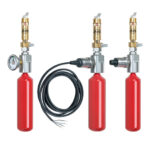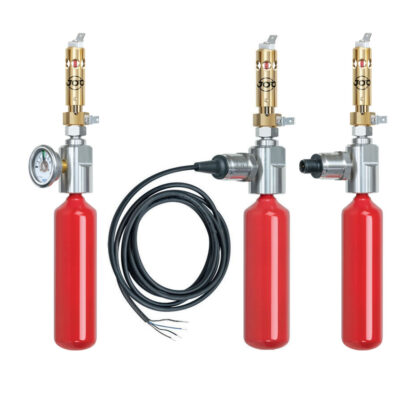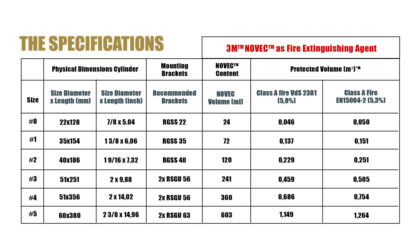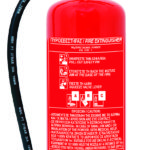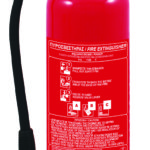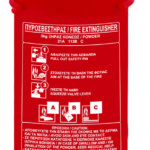ΑMFE – Automatic Miniature Fire Extinguisher
Code.:
ERP:AMFE
Product Information
Electricity is dangerous. Statistically, the fire services are called to a fire scene in Europe and North America every two minutes. Electricity, electrical systems and electronic devices cause one in three of these fires, In practice, there might be even more fires that are often not reported for fear of possible consequences such as investigations, raised insurance premiums or simply because prompt and competent intervention by the people who were there avoided more serious damage, particularly in industrial environments. The impact of fires is frequently devastating – not only for the people affected but also for the companies that are economically linked to such an incident. Costs for repairs and replacement of damaged equipment, vehicles or devices often represent the lesser evil – the largest damage is caused by the concomitant service interruptions.
THE SOLUTION – AMFE
Integrated fire protection systems fight fires at source of origin, when the fires are still small. AMFE systems are not only very small, but also work reliably and automatically 24/7. They are used to extinguish fires in e.g. electrical cabinets and other small electrical equipment, which are normally inaccessible for people.
THE FUNCTION
The billion-fold proved sprinkler glass bulb is also used in the AMFE. As with the sprinkler systems, the extinguishing process is initiated by the glass ampoule bursting due to heat. Because of its size, the AMFE can be placed directly at the hazard interface. It is characterized by the highest reliability without interruption and without being supplied with voltage. Glass ampoule, spring, needle, extinguishing cylinder – simple. GENIOUS! The AMFE is rugged and versatile. It has been extensively tested for vibration and environmental influences such as temperatures and humidity, as well as undergoing lifetime stress tests.
THE SPRINKLER BULB
In connection with the selection of the trigger head the correct sprinkler ampoule must be selected. It depends on the trigger temperature. It is the temperature at which the ampoule bursts and the extinguishing agent is released. We recommend a reserve of 20 Celsius to the maximum temperature at the installation site (e.g. in summer there can be up to 70°C in the control cabinet, then you should select the trigger temperature at 93°C to avoid an early release or mis-triggering).
AMFE: Thermal automatic activation
The AMFE is integrated into the circuit and, depending on the model, may be in contact with external devices. The wiring of the S-AMFE and R-AMFE is similar and is done via a flat connector. In the event of a fire, both AMFEN send a signal that there is a fire. However, the R-AMFE can also be triggered remotely via this wiring. This adds energy that causes the ampoule to burst.
S-AMFE: Monitoring of thermal activation
In case of activation, the signal current over the S-AMFE is interrupted by the glass bulb bursting and the Fire Control Panel becoming low-active (opening functionality). The relay is becoming low-active, opening the power contracts. As a result the power is shut off in case of fire, preventing the re-ignition.
R-AMFE: Monitoring and remote activation
The R-AMFE can be initiated by an external activation current. The bulb inside is intentionally overheated and will burst when reaching the activation temperature. And as always, should this remote-activation fail, the R-AMFE will operate by temperature (fire).
AMFE Cylinder Types
The AMFE series comprises 6 different sizes of extinguishing agent cylinders in four variations. The activation heads are user-assembled onto these red cylinders. In addition to the basic variant of cylinders, another variant has a permanent pressure disülay in the form of a factory-installed and leak-tested manometer / pressure gauge. This visually shows the internal pressure of the extinguishing agent cylinder. The nominal range (marked green) for the internal pressure is around 34 bar (T=20°C). This variant is designed for visual checks by the user of the AMFE extinguishing unit, directly on the device. For cases where a pressure gauge is not suitable (e.g. due to inaccessible mounting positions), the versions with electronic pressure sensors can be used. An analog 20-4mA sensor signal represents the actual pressure inside the cylinder and can be read out permanently e.g. through an analog input on a PLC. This allows for remote monitoring of both, activation and monitoring. This version allows fully remote operation (with permanent remote maintenance!)
HOW TO CHOOSE THE RIGHT SYSTEM
To ensure optimal protection for all kinds of equipment, there are two steps to consider when choosing the right system. In essence this involves choosing the appropriate extinguishing agent cylinders and release heads.
Step 1: How big is the volume to be protected? The general rule to choose a suitable extinguishing cylinder is: object volume – volume of installed components = free volume. Select the appropriate cylinder size that is able to protect the free volume.
Step 2: Which AMFE release head is the right one and when should it release? Choose the right AMFE release head based on your needs and requirements.
VdS certification G 622002 for S – AMFE & R-AMFE with gauge or pressure sensor
Small size, big effect. The freely selectable cylinder sizes make it possible to extinguish fires safely and effectively directly at the source with minimal use of extinguishing agent. Don´t give fire a chance and extinguish fires before they start! This not only saves money, but also time
THE EXTINGUISHING AGENT
NON – CONDUCTIVE AND CLEAN
Besides other agents, e.g. CO2, the AMFE system uses 3M Novec engineering fluid. This agent is liquid at room temperature. The boiling point is 49°C. Most importantly, Novec can be called a green agent and in case of activation the agent is non-conductive and won´t cause extinguishing related damages.
- Non – Toxic
- Non – Conductive
- Non – Corrosive
- No Residue after Initiation
- Zero Ozone Depletion Potential (0 ODP)
- Very Little Global Warming Potential

